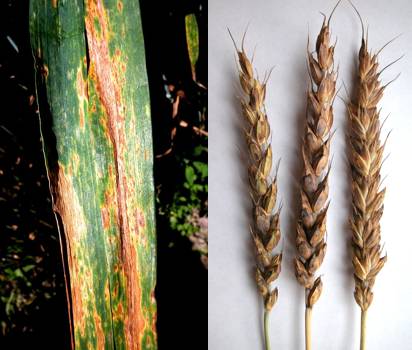Diseases
Leptosphaeria nodorum E. Muell. - Stagonospora nodorum Blotch of wheat = Glume Blotch = Stagnospora (Septoria) Glume Blotch
Systematic position.
Ascomycota, order Dothideales, family Leptosphaeriaceae, species L. nodorum. Anamorph Stagonospora nodorum (Berk.) Castell. et Germano (syn. Septoria nodorum (Berk.) Berk; Depazea nodorum Berk., Hendersonia nodorum (Berk.) Petr., S. glumarum Pass.).Biological group.
Hemibiotrophic wheat pathogen.Morphology and biology.
The pathogen S. nodorum infects all overground parts of plants. On leaves S. nodorum forms numerous small, irregular, oblong, dark brown flecks or spots with chlorotic border. Spherical, dark-brown semisubmerged, scattered or allocated linearly pycnidia are visible on leaf surface. On stems lesions are dark brown, indistinct, gradually decolorized; pycnidia develop rarely. On wheat heads the lesions begin as dark brownish spots on the glumes; then the lesions enlarge, the centers turn grayish-white in color, and pycnidia develop there. The disease can infect wheat seeds but without visible symptoms; infected grains become lighter in weight and punier than healthy ones. Fungus survives on infected plant refuses or seedlings or seed as pycnidia and mycelium. Conidia and ascospores serve as primary infection for inoculation of wheat seedlings. Ascomata (pseudothecia) are formed on overwintered wheat leaves. In period of wheat vegetation the pathogen disperses by conidia. Pycnidia of S. nodorum are spherical, dark-brown, 66-150 mkm in diameter, thin-walled; stoma is spherical, surround by layer of more dark cells. Conidia are rhabdoid or cylindrical, straightened or curved, with rounded apices, 13-38.4x2.0-3.0 mkm in size, uncolored and having 1, 2 or 3 septae. Ascoma is 160 to 300 mkm in diameter, with short conic stoma. Asci are cylindrically club-shaped, light-brown, 60-70x8-12 mkm. Ascospores are fusiform, light-brown, having 3 septae, 20-28x4-6 mkm in size.Distribution.
The pathogen S. nodorum is distributed everywhere, but dominates and wider occurs in North-West, Volga-Vyatka, North-Caucasus regions of Russian Federation, in the Urals, East and West Siberia, the Far East, Baltic countries, Byelorussia, Kazakhstan, Kyrgyzstan. In North region and northern part of Volga-Vyatka region the disease epiphytoty is registered 2 times for decade, and yield losses reach to 20%. In the Urals the Glume Blotch disease occurs only in zones with sufficiently high wetness; epiphytoty is registered 2 times for decade, yield losses are 10 to 20%. In the central regions of Non-Black Earth areas S. tritici and S. nodorum occur in approximately equal ratio. Epiphytoty is registered 4 years for decade, yield losses reach to 30%.Ecology.
The fungus and disease distribution strongly depends on meteorological conditions. Optimal temperature for conidia germination is 23.S and optimal moderate humidity is 100% (but drop-liquid humidity is better). Abundant and frequent rains play the main role in disease epithytoty on wheat. Deficiency of humidity in spring (in period of infection beginning) and later in summer time decreases the disease distribution on seedlings.Economic significance.
The pathogen occurs on spring and winter wheat, barley, rye, oat, and wilds cereals. In diseased plants an increased assimilative surface of leaves and heads juvenility are observed. Depending on S. nodorum head infection extent, weight of one spike decreases by 2.3 to 14.6%, weight of one grain by 8.3 to 27.3%, and weight of 1000 grains by 15.8 to 31.3%. Infected seeds are the sources of infection causing yield decrease in the next growing season. Germination of infected seeds decreases by 9.5 to 12% (the infection in middle and strong extent). Protection measures include chemical seed dressing, optimal sowing time, crop rotation, correct soil preparation (shelling of stubble and plowing), balanced application of fertilizing, spraying by fungicides during wheat vegetation, cultivation of resistant cultivars.Related reference:
Borzionova T.I., Vasetskaya M.N. Special feature of septoria disease in conditions of forest steppe and submontane Altai districts // Sibirskii vestnik s.-kh. nauki.- 1991, N1. - P. 43-46 (in Russian).Hawksworth D.L., Kirk P.M., Sutton B.C., Pegler D.N. 1995. Dictionary of the fungi. - CAB International Institute Kew: Surrey. - 663 pp.
Ishkova T.I., Berestetskaya L.I., Gasich E.V., Vlasov D.Y. 2001. Methodical instruction for diagnostics of major cereal fungal diseases. - St.Petersburg: VIZR. - 76 pp. (in Russian).
Koishibaev M., Ismailov E.T. 1991. Feature of development and harmfulness of septoria diseases of wheat in Kazakhstan // Bulletin s.-kh. nauk Kazakhstan.- N11.-P.31-36 (in Russian).
Rudakov O.V, Titova K.D., Pospekhov G.V., Fissura N.I. 1989. Zones of harmfulness of leaf spot blotches pathogens //Povyshenie produktivnosti i ustoichivosti proizvodstva zerna ozimoi pshenitsy v SSSR /Sbornik nauchnykh trudov. - Mironovka. - P.134-139 (in Russian).
Sanin S.A. 2000. To increase the level of phytosanitary safety of the country // Zashchita rastenii i karantin . - N12. - P. 3-7.
Sanina A.A., Antsiferova L.V. 1991. Species composition of spp. Septoria Sacc. on wheat in the European part of the USSR // Mycology and Phytophatology. - V. 25 (3). - P. 250-252 (in Russian).
Sanin S.S., Nazarova L.N., Sokolova E.A., Ibragimov T.S. 1999. Health of cereals field. Zashchita i karantin rastenii. - N2. - P. 28-31 (in Russian).
Shestiperova Z.I., Nikitina N.L. Powdery mildew and spot blotches on spring cereals. . Leningrad: Kolos, 1973. . P. 13-18 (in Russian).
Vasetskaya M.N. 1989. Actuality and perspectives of wheat septoriosis studies in the USSR // Povyshenie produktivnosti i ustoichivosti proizvodstva zerna ozimoi pshenitsy v SSSR (Sbornik nauchnuh trudov). - Mironovka. - P. 115-129 (in Russian).
Zakharenko V.A., Kuzmichev A.A., Plotnikov V.F., et al. 2000. Extent and trends of species composition and population structure changes, areas of harmful and useful organisms complexes, and forecast of dangerous phytosanitary situations in Russian regions. St. Petersburg: RASKhN. - P. 1-100 (in Russian).
Zakharenko V.A., Ovsyankina A.V., Sanin S.S., etc. 2003. Maps of distribution of harmful organisms, pathotipes, disease virulence genes, phytophages, entomopathogens in territory of Russian Federetion.-Moscow : Rosselkhozakademiya. - 64 pp. (in Russian).


